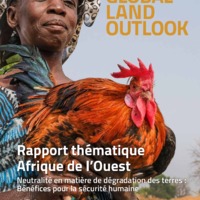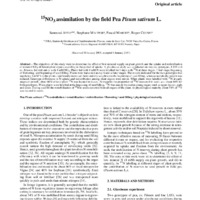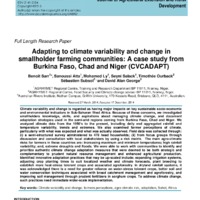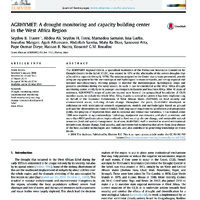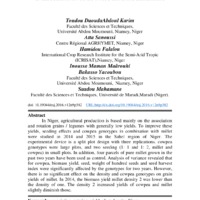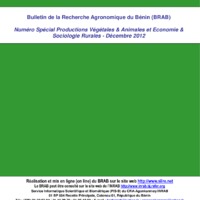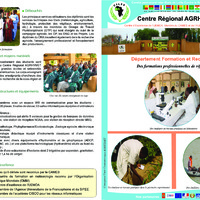Recherche
8 items
Global Land Outlook : Rapport thématique Afrique de l’Ouest. Neutralité en matière de dégradation des terres : Bénéfices pour la sécurité humaine
Le présent rapport thématique du GLO sur l’Afrique de l’Ouest et le Sahel a été élaboré par le Centre régional AGRHYMET dans le cadre d’un Mémorandum d’accord signé en 2019 entre le Comité permanent inter-États de lutte contre la sécheresse dans le Sahel (CILSS) et la Convention des Nations Unies sur la lutte contre la désertification (CNULCD). Ce travail a été accompli avec l’appui généreux de TetraTech, USAID et SERVIR Afrique de l’Ouest. Analysant les enjeux, contraintes et atouts de 7 pays sahéliens (Burkina Faso, Mali, Mauritanie, Niger, Nigéria, Sénégal et Tchad), ce rapport thématique régional met en lumière les acquis et opportunités existants pour favoriser le développement durable et inclusif de toute la région. Ainsi, faisant face à la dégradation des terres, de bonnes pratiques de Gestion Durable des Terres (GDT) ont été développées.
15NO3 assimilation by the field Pea Pisum sativum L.
Abstract – The objectives of this study were to determine the effect of low mineral supply on plant growth and the uptake and redistribution of mineral N by different plant organs according to the period of uptake. A glasshouse study was conducted on two pea genotypes, L833 and cv. Frisson, fed without or with 4 mM NO3. Plants fed with 4 mM N were labelled for 5 days with 15N at three stages: 7 leaf stage, beginning of flowering, and beginning of seed filling. Plants were harvested at day 6 and at later stages. The results indicated for the two genotypes that supplying 4 mM N to the plants significantly increased their total dry weight up to the beginning of seed filling, whereas nodule dry weight was reduced. Genotype differences in N uptake and redistribution among plant organs were minor. When plants were labelled with 15N at early stages of growth, about 60& of total plant 15N was located in leaves. At maturity the proportion of 15N recovered in seeds was about 60& for both genotypes. When plants were labelled at the beginning of seed filling, 15N was mainly located in young organs such as upper leaves, pods and seeds. During seed fill the remobilisation of 15N to seeds occurred from all organs of the plant. At physiological maturity about 70& of 15N was located in seeds.
Adapting to climate variability and change in smallholder farming communities: a case study from Burkina faso, Chad and Niger
Climate variability and change is regarded as having major impacts on key sustainable socio-economic and environmental indicators in Sub-Saharan West Africa. Because of these concerns, we investigated smallholders knowledge, skills, and aspirations about managing climate change, and document adaptation strategies used in the semi-arid regions coming from Burkina Faso, Chad and Niger. We analyzed climate data from the 1950’s to the present, including daily and aggregated rainfall and temperature variability, trends and extremes.
AGRHYMET: Adrought monitoring and capacity building center in the West Africa Region
The AGRHYMET Regional Center, a specialized institution of the Permanent Interstates Committee for Drought Control in the Sahel (CILSS), was created in 1974 at the aftermaths of the severe droughts that affected this region in the early 1970s. The mission assigned to the Center was to train personnel, provide adequate equipment for the meteorological and hydrological stations networks, and set up regional and national multidisciplinary working groups to monitor the meteorological, hydrological, crops and pastures conditions during the rainy season. As such, it can be considered as the West Africa drought monitoring center, similarly to its younger counterparts in Eastern and Southern Africa. After 40 years of existence, AGRHYMET’s scope of activities expend now beyond the geographical boundaries of CILSS member states, to include the whole West Africa thanks to several initiatives it has been implementing on behalf of the Economic Commission of West African States (ECOWAS) on food security and environmental issues, including climate change. Throughout the years, AGRHYMET developed, in collaboration with international research organizations, models and methodologies based on ground and satellite observations to monitor rainfall, food crop water requirements satisfaction and prospective yields, the progress of vegetation front and its seasonal and interannual variations. It has trained about 1200 new experts in agrometeorology, hydrology, equipment maintenance, and plant protection, and more than 6000 professionals on topics related to food security, climate change, and sustainable natural resources (land and water) management. As of now, AGRHYMET staff is involved in several international initiatives on climate change, food security, and environmental monitoring that allow them keep abreast of the best available technologies and methods, and also contribute to generating knowledge on those issues.
Amelioration Du Rendement Du Mil Par L’association Avec Le Niebe En Zone Sahelienne
Au Niger, la production agricole est essentiellement basée sur l’association et la rotation céréales/légumineuses avec des rendements généralement faibles. Afin d’améliorer ces rendements, les effets de densités de semis et de génotypes de niébé en association avec le mil ont été étudiés en 2014 et 2015 en zone sahélienne du Niger. Le dispositif expérimental est un split plot à trois répétitions. Les génotypes de niébé étaient en grandes parcelles, et les deux densités de semis (1 :1 et 1 :2, mil et niébé) en petites parcelles. Par ailleurs, quatre parcelles de mil pur cultivées au cours des deux années ont été utilisées comme témoin. L’analyse de variance révèle que pour le niébé, le rendement en biomasse, en graines, le poids de cent graines et l’indice de récolte en graines ont été significativement affectés par les génotypes pendant les deux années. Cependant, il n’y’avait aucun effet significatif de la densité et de génotypes de niébé sur les rendements en grains du mil. En 2014, le rendement en biomasse de mil à la densité 2 était inférieur à celui de la densité 1. La densité 2 augmentait les rendements du niébé et diminuent faiblement ceux du mil.
Bulletin de la Recherche Agronomique du Bénin (BRAB) Numéro Spécial Productions Végétales & Animales et Economie & Sociologie Rurales - Décembre 2012
La ville de Niamey est confrontée depuis plus d’une décennie à un problème de gestion des eaux usées domestiques et industrielles. Plusieurs projets pilotes de gestion des eaux usées ont été initiés, puis abandonnés compte tenu de la complexité du dispositif d’épuration. L’adoption des systèmes d’épuration à faible coût et facile à mettre en oeuvre s’avère plus que nécessaire. Cette étude s’inscrit dans ce cadre et vise d’une part à épurer les eaux usées par une technique simple basée sur un filtre de gravier planté de bourgou, et d’autre part à déterminer le rendement, la composition chimique et la valeur fourragère du bourgou en fonction de la filière d’épuration des eaux usées. Le bourgou (Echinochloa stagnina) est une graminée aquatique appétée par les animaux. Les essais ont été conduits sur le site expérimental de la station d’épuration de la Faculté des Sciences de l’Université Abdou Moumouni de Niamey. Les eaux usées utilisées pour ces expérimentations proviennent de la cité universitaire des étudiants. Les résultats obtenus après un suivi de deux mois et demi de croissance du bourgou dans deux filières distinctes de traitement des eaux usées montrent que la croissance du bourgou dépend non seulement de l’apport des éléments nutritifs donc de la nature des eaux usées, mais aussi de l’oxygénation des plantes. Les différentes analyses ont permis également de déterminer la composition chimique du bourgou en fonction de la filière d’épuration des eaux usées. Les résultats de cette étude constituent une avancée dans les techniques de traitement des eaux usées dans les pays pauvres.
plaquette DFR 2015
Les formations du Centre Régional AGRHYMET visent le renforcement des capacités, de conception et d’exécution des cadres africains dans les domaines de la sécurité alimentaire, de la gestion des ressources naturelles, de la lutte contre la désertification, de la protection des végétaux et de l’environnement. Le succès des formations du CRA s’explique par l’adéquation entre les offres de formation et les préoccupations des populations et la qualité des cours dispensés. Entre 1974 et 2013, le CRA a formé plus de 1000 diplômés pour les pays de l’espace CILSS/CEDEAO et de l’Afrique Centrale. En matière de formations continues, plus de 6 000 cadres des services techniques des pays ont suivi des stages de perfectionnement au CRA.
VARIATION IN MACRO-ELEMENTS AND PROTEIN CONTENTS OF ROSELLE (HIBISCUS SABDARIFFA L.) FROM NIGER
Roselle is an important part of the human diet in many countries, particularly in the Sahel zone of West Africa. The leaves of Roselle are consumed as a green vegetable and in sauce. Nevertheless, little attention has been paid to their nutrient composition at different stages of plant growth. Therefore, an experiment was carried out under rainfall conditions from July to September 2006 at the experimental station of the Agrhymet Regional Centre in Niamey (Niger). The contents of Ca, K, Mg, P and protein in leaves of three ecotypes (A3, A7 and A9) were determined at stages I, II and III, corresponding, respectively to vegetative, flowering and mature stages. The experimental design was a randomized complete block with four replicates and one variable (ecotype). For ecotype A7, the protein content of the leaves decreased significantly (p<0.05) between stage I and II, than remained relatively constant up to stage III. In contrast for A3 and A9, protein content in leaves decreased significantly (p<0.05) between stage II and III. From stage I to III, the decrease of protein content in leaves was 41& for ecotype A3, 50& for A7 and 66& for A9. For all ecotypes, the P content of the leaves decreased progressively during plant growth. For A7 and A9, the reduction in P content from stage I to II and from II to III was about the same, namely 30&. However, for ecotype A3, the decrease was greater, respectively, 37& and 46&. The Mg content of the leaves was relatively constant for all three ecotypes at a given stage of plant development. However, the Mg content of the leaves decreased significantly (p<0.05) from flowering to maturity: 28& for A3, 23& for A9 and 14& for A7. For the three ecotypes, the Ca content of the leaves remained relatively constant from stage I to II, than increased markedly from stage II to III, to about 150& for A7, 85& for A3 and 50& for A9. From stage I to II, the leaves’ K content decreased significantly for all three ecotypes, about 67& for A9, 62& for A3 and 44& for A7. The data indicated that Roselle can contribute useful amounts of essential nutrients such as Ca K, Mg, N and P mainly at vegetative stage in the diets of people who inhabit the western Sahel.
